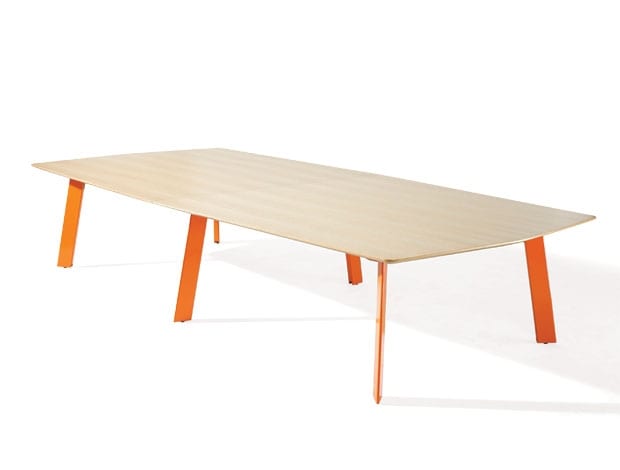 ||
||
ThinkingWorks’ collection of tables is impressive in its flexibility, with a modular system of components (leg, connecting hub, rail and top) producing a multitude of options
I last wrote about Australian manufacturer ThinkingWorks back in 2011 when, under the badge of Thinking Ergonomix, it had just opened its Clerkenwell Road showroom and was aiming to make a splash in the UK market. At the time it was keen to ram home its environmental credentials and persuade anyone who would listen that it was just as green to ship its legs and frames from the other side of the world than to shop local and put components on a lorry.
As I chat to the company’s sales manager Grant Hagen, over for a short visit from Sydney during Clerkenwell Design Week, it becomes clear that the message has become nuanced. You sense the firm no longer has to justify its presence in a far-away market; that it is more comfortable in its UK skin. The eco message remains a part of its offering but no longer appears to be up front and centre.
I’m here to discuss its table, Blade, which was designed by the company’s in-house team in 2013 and is notable for its leg detail. “The design ethos is one leg, one hub,” Hagen tells me proudly. As tag lines go I’m not convinced it’s the most catchy. In fact there’s a momentary pause as (I suspect) I look at him blankly.
The hub he’s referring to is a chunky, circular steel component that attaches the legs to the frame. It also transpires the slogan is technically a bit of a fib because in actual fact there are two types of hub – one that can be fixed at a 90° angle or a three-way version that allows the legs to be set in a variety of positions.
It’s this component that is key to a system that encompasses a vast range of products, from standing-height tables to boardroom options, through to a multi-person workstation with a full range of accessories. It can also be positioned on the outside or inside of the frame, meaning that the legs can be hidden from clear view, giving a boardroom table a pleasantly clean, uncluttered line.
The steel frame can be finished with tops in any number of materials and Hagen is keen to emphasise the company’s flexibility. Around 10% of its work is specials – one client specified a marble top weighing 500kg, for instance, while another wanted a table 10m long. The accompanying marble-topped benches were created only six weeks ago at a client’s request.
It should be pointed out that while the steel frame and legs gives the system strength – allowing it to carry the marble table tops comfortably – it does make the product very heavy. You won’t be tempted to pick the benches up and move them around your workplace for those flexible, ad-hoc meetings that are currently all the rage, for example.
However, the real talking point here is the triangular-shaped leg with radiused edges, from which the product presumably derives it name. I wonder if there’s any practical reason for their shape? Not really, appears to be the answer. Hagen flirts with the notion that it helps to separate out the power and the data cables that run through the insides and into the frame (I’m not entirely certain how) before concluding that it’s “just the aesthetic”.
Obviously its a rounded triangle. It’s just a very soft aesthetic… Angular and square legs have been done to death, round tubes have been done to death, so clients are wanting a slightly different aesthetic basically. I’m not sure I entirely agree with Hagen’s assertion that there’s a softness to the product’s look. To my mind its styling has an engineered feel, something that’s reinforced by the website’s imagery of a bunch of technicians sporting Stig-style motorcycle helmets in a lab staring at the piece as though it’s a Formula One car. Its name doesn’t exactly imply a feminine aesthetic either.
The version I’m looking at has a rather disconcerting, trompe-l’oeil timber finish which wouldn’t be my preference, but here again it’s possible to specify from a wide variety of choices. Price obviously depends on what the client specifies but Hagen is convinced it’s competitive with its mid-range rivals. If not exactly startling, Blade is a very decent piece of work.





















